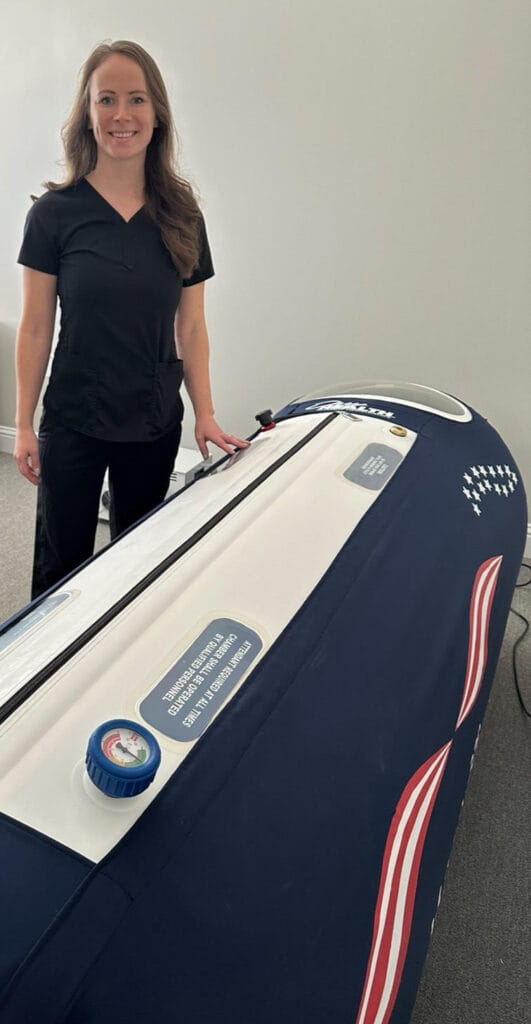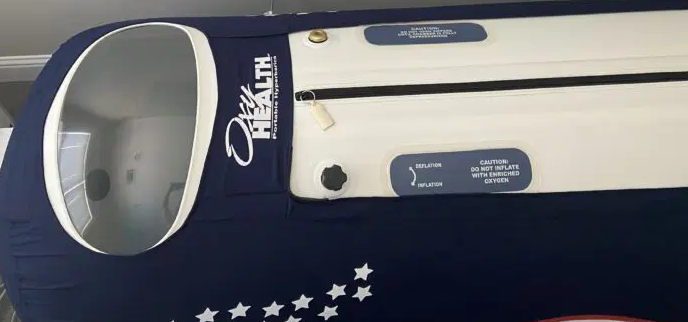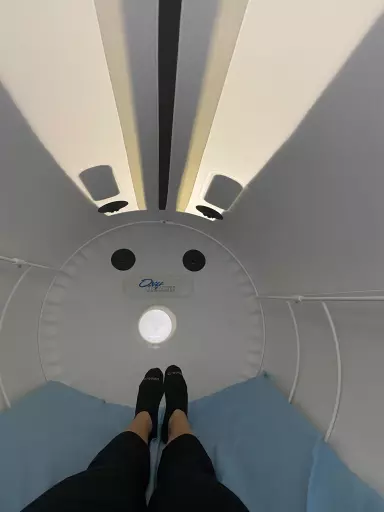Hyperbaric Oxygen Therapy
What is Mild Hyperbaric Oxygen Therapy (mHBOT)?
Mild Hyperbaric Oxygen Therapy (mHBOT) is a non-invasive treatment that involves breathing supplemental oxygen using an oxygen concentrator in a pressurized soft chamber and is administered above “1.3 absolute atmospheres, or 1.3 ATA”.
mHBOT is a treatment that Dr. Diana Tyler uses for her patients that have neurological disorders at the Aura Functional Neurology Center (Aura FNC) facility located in Cumming, Georgia, only about 20-30 minutes from the Atlanta Metro area.
Being that many neurological conditions are from damage within our nerves and circulatory systems, mHBOT can help by increasing the amount of oxygen your blood can carry, which stimulates healing, reduces inflammation, and improves overall mitochondrial and physical health. Hyperbaric chambers can also boost your immune function, assist in detoxification, enhance sports performance by accelerating muscle recovery, and even have anti-aging effects.
While mHBOT is a simple and non-invasive procedure, its potential benefits are vast, and they serve as important tools in promoting health and well-being. Alongside the treatments that we use in the field of functional neurology to promote positive changes in the spinal cord and aid the brain, HBOT has also been shown to have a direct impact on neuroplasticity.
One of the main benefits of using a soft chamber closer to “1.3 ATA”, and largely why we prefer mHBOT over HBOT at Aura FNC, is because there is less of a risk of a condition called barotrauama at lower absolute atmospheres. Barotrauma can cause stress on the eardrum when the air pressure in the ears versus the air pressure in the environment is out of balance. This is important to avoid, as many of the patients we treat at Aura FNC are unable to communicate their physical needs. On top of this, soft chambers or mHBOTs can be purchased for at-home use, for our patients who need hyperbaric treatment over the long term.

Dr. Diana Tyler DC, DACNB
Founder of Aura Functional Neurology Center. Doctor of Chiropractic and Functional Neurologist. Extensive experience treating patients with Mild Hyperbaric Oxygen Therapy (mHBOT). Graduate of Palmer College of Chiropractic and a Diplomate of the American Chiropractic Neurology Board.

OxyHealth Vitaeris 320
HBOT vs mHBOT
Hyperbaric Oxygen Therapy (HBOT) is different than mHBOT in that it is defined as a medical and neurological treatment that involves breathing pure oxygen (rather than using an oxygen concentrator) in a pressurized room or hard chamber, also known as a hard-shell hyperbaric chamber. Hyperbaric Oxygen Therapy (HBOT) usually refers to the highest of pressures achieved from a hard chamber or hospital-grade HBOT administered above “2.0 absolute atmospheres, or 2.0 ATA”.
The fundamental principle behind HBOT is to increase the amount of oxygen delivered to the body’s tissues and organs, significantly surpassing what can be achieved with normal atmospheric pressure. This heightened oxygen concentration supports various healing processes, as oxygen plays a crucial role in cell repair, tissue regeneration, and overall immune function. The process involves the patient entering a hyperbaric chamber, where the atmospheric pressure is increased, allowing the lungs to take in more oxygen than they could at normal pressure levels. The pure oxygen is then transported through the bloodstream to promote healing and alleviate certain medical and neurological conditions.
Hyperbaric Oxygen Therapy has gained recognition for its versatility in treating a range of conditions. From promoting wound healing and reducing inflammation to aiding in the management of certain infections, HBOT has proven beneficial for a variety of medical and neurological issues. By leveraging the power of increased oxygen levels under pressure, this therapy provides a non-invasive and well-tolerated approach to support the body’s natural healing mechanisms.
Aura FNC only offers mHBOT hyperbaric treatment using a soft chamber with an oxygen concentrator at ~1.3 ATA. Aura FNC does not offer HBOT hyperbaric treatment using a hard chamber with pure oxygen above > 2.0 ATA.

Types of Hyperbaric Oxygen Chambers
Hyperbaric oxygen therapy employs various types of chambers designed to deliver therapeutic oxygen in a pressurized environment. Monoplace chambers, designed for individual use, are spacious tubes that accommodate a single person. These chambers provide a comfortable and controlled environment, allowing the patient to breathe supplemental oxygen while the atmospheric pressure is increased. Multiplace chambers, on the other hand, are larger and can accommodate multiple individuals, often with medical staff present. These chambers allow for more extensive medical and neurological care during the therapy session, making them suitable for patients requiring additional monitoring or assistance.
Additionally, there are mild hyperbaric chambers, also known as soft chambers or mild chambers. These portable and flexible chambers operate at lower pressures compared to traditional hyperbaric chambers. While they are not FDA-approved for all medical or neurological conditions, they are sometimes used in certain clinical settings. The choice of chamber depends on the specific medical or neurological needs of the patient and the nature of the condition being treated. The versatility in chamber types ensures that hyperbaric oxygen therapy can be tailored to individual requirements, providing a range of options to suit various healthcare scenarios.
List of Hyperbaric Oxygen Chambers:
- Monoplace Hyperbaric Chambers (HBOT)
- Multiplace Hyperbaric Chambers (HBOT)
- Mild Hyperbaric Chambers (mHBOT Soft Chamber – the type of chamber we use at Aura FNC)
These chambers vary in design, capacity, and application, allowing healthcare professionals to select the most appropriate chamber for a patient’s specific medical or neurological needs.

FDA-Cleared Conditions for Marketing HBOT
Hyperbaric oxygen therapy and the oversight by the FDA play crucial roles in ensuring the safety and efficacy of this medical and neurological treatment. Our body’s tissues rely on oxygen for proper functioning, and while the air we breathe contains 21% oxygen, HBOT involves breathing 100% pure oxygen within a specialized hyperbaric chamber. The FDA meticulously regulates both the oxygen used in HBOT and the hyperbaric chambers, which can be individual tubes or larger rooms accommodating multiple individuals. This regulatory oversight ensures that the therapy is administered safely, as too much oxygen, although therapeutic, can potentially cause harm to the body.
FDA clearance for hyperbaric chambers is granted based on rigorous evaluations. The agency’s clearance indicates that a particular chamber has the same intended use and is as safe and effective as other legally marketed devices of its kind. As of July 2021, the FDA has cleared hyperbaric chambers for specific disorders, including:
- “Air and gas bubbles in blood vessels
- Anemia (severe anemia when blood transfusions cannot be used)
- Burns (severe and large burns treated at a specialized burn center)
- Carbon monoxide poisoning
- Crush injury
- Decompression sickness (diving risk)
- Gas gangrene
- Hearing loss (complete hearing loss that occurs suddenly and without any known cause)
- Infection of the skin and bone (severe)
- Radiation injury
- Skin graft flap at risk of tissue death
- Vision loss (when sudden and painless in one eye due to blockage of blood flow)
- Wounds (non-healing, diabetic foot ulcers)”
It’s important to note that while HBOT is being explored for various conditions, including COVID-19, the FDA has not yet cleared or authorized the use of any HBOT device for treating conditions beyond those specified. Clinical trials for HBOT and COVID-19 can be explored on the clinicaltrials.gov website for more information.
While these are FDA-approved treatments using a hard-shell HBOT above > 2.0 ATA, there is a lot of literature that shows a significant impact that both mHBOT and HBOT have below < 2.0 ATA on treating some of these disorders and other conditions such as Dysautonomia, Postural Orthostatic Tachycardia Syndrome (POTS), Concussion, Post-concussive Syndrome (PCS), Traumatic Brain Injury (TBI), Neurodevelopmental Disorders (NDDs) such as Autism, and more. At Aura FNC we’re always trying to share more of this type of education and literature through our Neuroscience Blog if you’d like to learn more.
What to Expect During mHBOT at Aura FNC?
During a typical mHBOT session at Aura Functional Neurology Center (Aura FNC), which generally lasts between 60 minutes to 2 hours, you will enter a specially designed, sealed chamber. The air pressure inside this chamber is increased to 1.3 times the normal atmospheric pressure. You will then breathe in oxygen, through a mask or a cannula. The combination of increased pressure and high concentration of oxygen allows your lungs to gather more oxygen than they would at normal air pressure.
The procedure is generally comfortable and safe. What sets mHBOT apart is the patient’s experience within the chamber. As you settle into the pressurized environment, you may feel a subtle fullness in your ears, similar to the sensation during a flight. This is a normal response to the changing pressure levels and can often be relieved by yawning or swallowing. Throughout the session, you’ll have the flexibility to engage in various activities such as reading, watching a movie, or listening to music, making the experience personalized and conducive to relaxation.
As the session progresses, you may also notice a mild increase in temperature within the chamber. This is a normal response to the pressurized environment and the body’s heightened oxygen intake. Many individuals find this warmth soothing, contributing to an overall sense of well-being during the mHBOT experience. The combination of increased pressure, enriched oxygen levels, and the gentle rise in temperature creates a therapeutic environment aimed at supporting your body’s natural healing processes.
Throughout the session, Dr. Diana Tyler overseeing your mHBOT journey is readily available to address any questions or concerns via a handheld transceiver (Walkie-Talkie), ensuring your comfort and safety and optimizing the benefits of this therapy.

What to expect after mHBOT at Aura FNC?
The therapeutic effects of mHBOT extend beyond the session itself. Following the completion of a session, it’s common to experience a sense of rejuvenation and increased energy levels. Some individuals notice improvements in sleep patterns and cognitive function over time. It’s essential to communicate any sensations or concerns with the healthcare professionals overseeing your mHBOT sessions, ensuring a tailored and comfortable experience that aligns with your unique health goals.
At Aura FNC, we’re trying to promote as optimal of brain health as possible. Here are some of the ways that we promote brain health using mHBOT through the lens of Functional Neurology:
- Neurogenesis:
mHBOT has shown promise in promoting neurogenesis, the formation of new neurons in the brain. The increased oxygen levels delivered during mHBOT stimulate neural stem cells, supporting their differentiation into functional neurons. This process may enhance cognitive function and contribute to neurological recovery in conditions such as traumatic brain injury and neurodegenerative disorders. - Angiogenesis:
Cerebral angiogenesis, the formation of new blood vessels or nerve fibers, is a crucial process in tissue repair and regeneration. mHBOT has been demonstrated to stimulate angiogenesis by promoting the release of growth factors and cytokines. The heightened oxygen levels facilitate the development of new capillaries, improving blood flow to tissues, and can support both white and gray microstructures. This angiogenic effect is particularly relevant in wound healing, diabetic foot ulcers, and conditions where enhanced vascularization is beneficial. - Stem Cells:
mHBOT has been implicated in influencing stem cell behavior and function. The therapy creates a favorable environment by providing increased oxygen levels, which may enhance the survival and proliferation of various types of stem cells. This is particularly relevant in regenerative medicine, where the mobilization and activation of endogenous stem cells can contribute to tissue repair and recovery in conditions ranging from musculoskeletal injuries to degenerative diseases.
These physiological effects highlight the multifaceted impact of mild hyperbaric oxygen therapy on cellular processes, showcasing its potential as a modality that extends beyond mere oxygen delivery to actively participate in the regeneration and repair of tissues in various medical and neurological conditions.
Risks of mHBOT and/or HBOT
Both Hyperbaric Oxygen Therapy (HBOT) or Mild Hyperbaric Oxygen Therapy (mHBOT) are generally considered safe; however, like any medical or neurological intervention, it is important to be aware of potential risks. One potential risk we’ve already mentioned is barotrauma, which involves changes in pressure causing damage to air-containing structures, such as the ears or sinuses. To mitigate this, patients are carefully instructed on techniques like swallowing or equalizing ear pressure during sessions.
Some individuals may experience temporary changes in vision due to the pressurized environment. These effects are typically mild and reversible, but healthcare professionals carefully assess and monitor each patient to ensure their well-being throughout the HBOT or mHBOT process. It’s crucial for individuals undergoing HBOT or mHBOT to discuss their medical history comprehensively with healthcare providers, allowing for personalized risk assessments and the implementation of tailored safety measures.
Dr. Diana Tyler and the staff at Aura FNC closely manage the duration and intensity of each session to mitigate this risk for our patients and ensure the therapy’s overall safety. By fostering open communication with our patients at Aura FNC, any potential concerns or pre-existing conditions can be thoroughly addressed, allowing for a tailored and secure mild hyperbaric oxygen therapy experience.
Additional Information on HBOT and mHBOT
Beyond the specific conditions cleared by the FDA for hyperbaric oxygen therapy, ongoing research continues to explore the therapy’s potential applications. Clinical trials are underway to assess its effectiveness in addressing various medical and neurological conditions, including neurological disorders, chronic inflammatory conditions, and even its potential role in enhancing post-surgical recovery. It is essential for individuals considering hyperbaric oxygen therapy to stay informed about emerging research findings, as advancements in the field may broaden the spectrum of conditions for which HBOT or mHBOT could be beneficial.
It’s also noteworthy that hyperbaric oxygen therapy is often a complementary treatment, integrated into a comprehensive healthcare plan. It works synergistically with other medical interventions and therapeutic modalities, emphasizing the importance of collaborative care. Individuals seeking HBOT or mHBOT should engage in open communication with their healthcare providers, discussing their overall treatment plan and exploring how hyperbaric oxygen therapy or mild hyperbaric oxygen therapy can be integrated to enhance their well-being.
As technology and neurological knowledge advance, the field of hyperbaric oxygen therapy may evolve, potentially leading to innovations and broader applications in the field of functional neurology. Always consult with healthcare professionals for personalized guidance and the most up-to-date information related to hyperbaric oxygen therapy.
